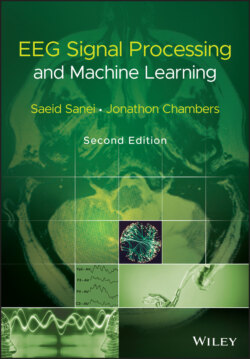Читать книгу EEG Signal Processing and Machine Learning - Saeid Sanei - Страница 71
4.5.1.4 Multiresolution Analysis
ОглавлениеMultiresolution analysis results from the embedded subsets generated by the interpolations (or down‐sampling and filtering) of the signal at different scales. A function f(t) is projected at each step j onto the subset Vj . This projection is defined by the scalar product cj (k) of f(t) with the scaling function φ(t), which is dilated and translated:
(4.29)
where 〈·, ·〉 denotes an inner product and φ(t) has the property:
(4.30)
where the right side is convolution of h and ϕ. By taking the Fourier transform of both sides:
(4.31)
where and are the Fourier transforms of h(t) and ϕ(t) respectively. For a discrete frequency space (i.e. using the DFT) the above equation (Eq. 4.31) permits the computation of the wavelet coefficient Cj + 1(k) from Cj (k) directly. If we start from C 0(k) we compute all Cj (k), with j > 0, without directly computing any other scalar product:
(4.32)
where k is the discrete frequency index.
At each step, the number of scalar products is divided by two and consequently the signal is smoothed. Using this procedure, the first part of a filter bank is built up. In order to restore the original data, Mallat uses the properties of orthogonal wavelets, but the theory has been generalized to a large class of filters by introducing two other filters and , also called conjugate filters. The restoration is performed with:
(4.33)
where wj + 1(∙) are the wavelet coefficients at the scale j + 1 defined later in this section. For an exact restoration, two conditions have to be satisfied for the conjugate filters:
Anti‐aliasing condition:
(4.34)
Exact restoration:
(4.35)
In the decomposition, the input is successively convolved with the two filters H (low frequencies) and G (high frequencies). Each resulting function is decimated by suppression of one sample out of two. The high frequency signal is left, and we iterate with the low frequency signal (left side of Figure 4.7). In the reconstruction, we restore the sampling by inserting a zero between each sample, then we convolve with the conjugate filters and , we add the resulting outputs and we multiply the result by 2. We iterate up to the smallest scale (right side of Figure 4.7). Orthogonal wavelets correspond to the restricted case where:
(4.36)
Figure 4.7 The filter bank associated with the multiresolution analysis.
(4.37)
(4.38)
and
(4.39)
We can easily see that this set satisfies the two basic relations (4.72) and (4.73). Among various wavelets, Daubechies wavelets are the only compact solutions to satisfy the above conditions. For bi‐orthogonal wavelets we have the relations:
(4.40)
(4.41)
and
(4.42)
The relations (4.34) and (4.35) have to be also satisfied. A large class of compact wavelet functions can be used. Many sets of filters were proposed, especially for coding [22]. It was shown that the choice of these filters must be guided by the regularity of the scaling and the wavelet functions. The complexity is proportional to N. The algorithm provides a pyramid of N elements.
